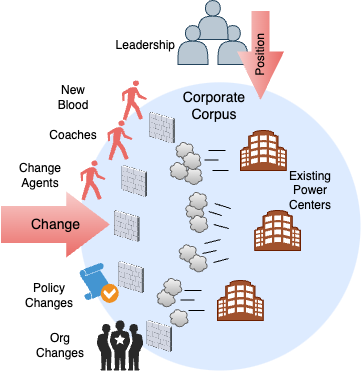Organizational response to transformation - white blood cells swarming to stop an infection
Transformation is hard and people only tend to do it when a situation is untenable or the evidence undeniable. You have to be willing to break things when you transform and it is often hard to stand up to the scrutiny of doing it prior to some major problem.
A retired executive and I were talking the other day. I told them about two places that rolled back their transformation efforts after a regime change where the transformation champions left or were reorganized out of that role. The exec said that we were in the phase where seeing:
The white blood cells were swarming the transformation infection to eradicate it.
The strong biological reaction to change feels like a corporate autoimmune disorder.
Video
General
Corporate transformations exist to address perceived shortcomings or to deal with new competitors or markets.
- Senior leadership decides that a change must be made.
- They then pick an approach that spawns new policies, organizations, and behaviors.
- Existing power centers are adjusted to align with the new direction.
- New transformation groups are created.
- Training is offered.
- The daily and mid-level workflows are adjusted to the new policies and ownership/authority models. Some oversight is created to monitor the progress.
- Teams get measured on their transformation maturity.
- Plan Do Measure Adjust takes over the continuous improvement process.
That is the positive side of the process. The reality is:
Teams "customize" the transformation to align more with how they previously operated. Teams attempt "adjust" transformation processes and techniques because "they were already doing most of it". They follow the form of the transformation without touching the spirit except where they see the easy value. They may comply with the changes without actually transforming. This can be a version of "working to the pay plan" or it can be that they have too much work to do and are forced to support the previous and new transformation workloads, reports, and metrics.
White blood cell attack the change agents and change processes.
7 Deadly Sins of Strategy
Transformations are big strategy plays that can fail for similar reasons as other strategy failures, see Seven Deadly Sins of Strategy by Jeroen Kraaijenbrink.
- Misreading Resistance,
- Behavior Compliance,
- Reinterpretation.





Comments
Post a Comment